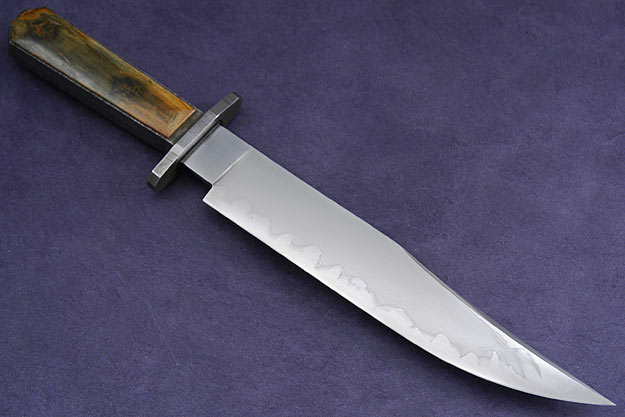Here are just my two cents and they are probly not worth that but here it goes. My experience with the 10xx series steel are that they do need a fast quench as everyone knows. When using vegetable oil use it at room temp. Not Heated. When you quench use a large volume of oil like 2 or 3 gallons ( I think I have four in a large drum). When you quench do not hold the blade in the same place move it back and forth Not side to side But back and forth like you are cutting through the oil with the edge. Parks 50 also works great with the 10xx series steel.
Now here is the crazy part. You all my think this is crazy or B.S. but think what ya wish! I seen one of Bill Burkes blades he posted on another forum with a crazy awesome Hamon and I asked him if it was some W-2. He replied no it was 1095 in a straight water quench! He had clay coated for the hamon and went straight from nonmag. to the water and quenched. I am not exacly sure on how long he went in the water. I have heard some people say they go in the water for 2 seconds then out for 2 second and then back in until cool, but like I said I'm not exactly sure what he done in the water. So I thought My Hell I have to try that! I have done the 1095 in room temp water now about five or six times now and have not cracked a single blade. I did have one warp the tip slightly that was ground to thin to begin with.
I hope some of this jibberish helps take from it what you wish. I do think mineral oil and parks AAA are to slow for the 10xx steels though.
Now here is the crazy part. You all my think this is crazy or B.S. but think what ya wish! I seen one of Bill Burkes blades he posted on another forum with a crazy awesome Hamon and I asked him if it was some W-2. He replied no it was 1095 in a straight water quench! He had clay coated for the hamon and went straight from nonmag. to the water and quenched. I am not exacly sure on how long he went in the water. I have heard some people say they go in the water for 2 seconds then out for 2 second and then back in until cool, but like I said I'm not exactly sure what he done in the water. So I thought My Hell I have to try that! I have done the 1095 in room temp water now about five or six times now and have not cracked a single blade. I did have one warp the tip slightly that was ground to thin to begin with.
I hope some of this jibberish helps take from it what you wish. I do think mineral oil and parks AAA are to slow for the 10xx steels though.
Last edited:

